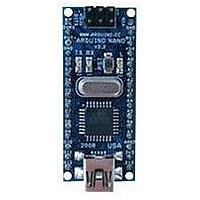A000005 Arduino, A000005 Datasheet - Page 4

A000005
Manufacturer Part Number
A000005
Description
ARDUINO NANO Board
Manufacturer
Arduino
Series
-r
Type
MCUr
Specifications of A000005
Silicon Manufacturer
Atmel
Core Architecture
AVR
Features
Powered Via The Mini-B USB Connection, 16KB Of Flash Memory For Storing Code
Kit Contents
Board Only
Silicon Family Name
Atmega
Processor To Be Evaluated
ATmega168
Processor Series
ATmega
Data Bus Width
8 bit
Interface Type
USB, RS-232
Operating Supply Voltage
6 V to 20 V
Silicon Core Number
ATmega168, ATmega328
Contents
Board
Lead Free Status / RoHS Status
Lead free / RoHS Compliant
For Use With/related Products
ATmega328
Lead Free Status / RoHS Status
Lead free / RoHS Compliant
Reset. Bring this line LOW to reset the microcontroller. Typically used to add a reset button to shields which block
the one on the board.
See also the
mapping between Arduino pins and ATmega168 ports
.
Communication
The Arduino Nano has a number of facilities for communicating with a computer, another Arduino, or other
microcontrollers. The ATmega168 and ATmega328 provide UART TTL (5V) serial communication, which is available on
digital pins 0 (RX) and 1 (TX). An FTDI FT232RL on the board channels this serial communication over USB and the
FTDI drivers
(included with the Arduino software) provide a virtual com port to software on the computer. The Arduino
software includes a serial monitor which allows simple textual data to be sent to and from the Arduino board. The RX and
TX LEDs on the board will flash when data is being transmitted via the FTDI chip and USB connection to the computer
(but not for serial communication on pins 0 and 1).
A
SoftwareSerial library
allows for serial communication on any of the Nano's digital pins.
The ATmega168 and ATmega328 also support I2C (TWI) and SPI communication. The Arduino software includes a Wire
library to simplify use of the I2C bus; see the
documentation
for details. To use the SPI communication, please see the
ATmega168 or ATmega328 datasheet.
Programming
The Arduino Nano can be programmed with the Arduino software (download). Select "Arduino Diecimila, Duemilanove,
or Nano w/ ATmega168" or "Arduino Duemilanove or Nano w/ ATmega328" from the Tools > Board menu (according
to the microcontroller on your board). For details, see the
reference
and tutorials.
The ATmega168 or ATmega328 on the Arduino Nano comes preburned with a
bootloader
that allows you to upload new
code to it without the use of an external hardware programmer. It communicates using the original STK500 protocol
(reference,
C header
files).
You can also bypass the bootloader and program the microcontroller through the ICSP (In-Circuit Serial Programming)
header; see
these instructions
for details.
Automatic (Software) Reset
Rather then requiring a physical press of the reset button before an upload, the Arduino Nano is designed in a way that
allows it to be reset by software running on a connected computer. One of the hardware flow control lines (DTR) of the
FT232RL is connected to the reset line of the ATmega168 or ATmega328 via a 100 nanofarad capacitor. When this line is
asserted (taken low), the reset line drops long enough to reset the chip. The Arduino software uses this capability to allow
you to upload code by simply pressing the upload button in the Arduino environment. This means that the bootloader can
have a shorter timeout, as the lowering of DTR can be well -coordinated with the start of the upload.
This setup has other implications. When the Nano is connected to either a computer running Mac OS X or Linux, it resets
each time a connection is made to it from software (via USB). For the following half-second or so, the bootloader is
running on the Nano. While it is programmed to ignore malformed data (i.e. anything besides an upload of new code), it









